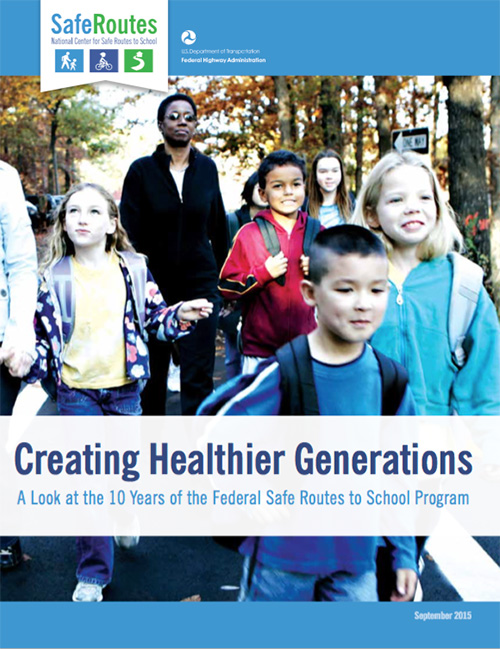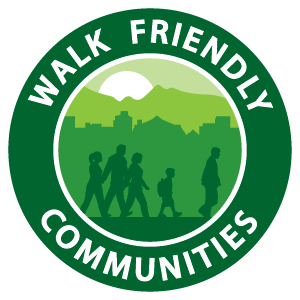
DIRECTIONS
Winter 2016News Briefs
Report celebrates a decade of the Safe Routes to School program’s success

A new report, Creating Healthier Generations: A Look at 10 Years of the Federal Safe Routes to School Program, released by the National Center for Safe Routes to School, examines the accomplishments of the Federal Safe Routes to School Program over the past decade.
Since the Safe Routes to School (SRTS) program was established by Congress in 2005, nearly 18,000 schools teaching kindergarten through eighth grades in all fifty states and the District of Columbia have been a part of SRTS. The program has reached more than 6.8 million students nationwide, with underserved schools well represented, and has demonstrated safe transportation and health benefits of active travel for these students.
This report highlights the program’s rich data and features stories of SRTS-funded projects that show the accomplishments and change the program has had on communities nationwide. Data show the program improved safety and increased the number of students walking and biking to school. For example, in Miami-Dade County, SRTS is part of a comprehensive program that measured a 63 percent reduction in child pedestrian injuries, while a program at Heatherwood Elementary in Boulder, Colorado, reported a dramatic increase in walking and bicycling to school and introduced children with autism to riding tandem bikes. Not only has SRTS improved safety and active transportation, the program has also found broader benefits such as increased connectivity within communities, reduced transportation costs, enhanced community life and more. This report also examines how communities continue to find ways to include safe walking and bicycling infrastructure into transportation planning.
Part of NCDOT’s TEAAS training will soon be available online
HSRC recently completed the development of the online course for the North Carolina Department of Transportation (NCDOT). The course, previously conducted in person, reviews basics such as a description of the Traffic Engineering Accident Analysis System (TEAAS), the information it contains (reported crashes since 1990, and information on roadways, mileposting, crash codes, ordinances and user information). It explains what types of crashes are “reportable,” and describes three different levels of crash data that can be collected and which types are available in TEAAS. Exercises throughout the course and an end-of-course quiz test comprehension after completion of the unit.
Plans are underway with NCDOT to develop a final 2016 training schedule, but the training’s online materials offer improvements and flexibility for both students and instructors. The former two-day in-person course will now require one day of in-person training to supplement the online TEAAS module that will be completed in advance.
Wake County schools and community partners unite to improve child pedestrian safety

Pedestrian-motor vehicle crashes are the third leading cause of death among Wake County children under 18, but a new effort is aiming to change that. A collaborative project between HSRC, the Wake County Public School System, the Capital Area Metropolitan Planning Organization, and other partners will create Safe Routes to School (SRTS) model programs at five schools to improve safety and enable more students and families to walk to school. This John Rex Endowment grant-funded project also involves working with local agencies to examine municipal and school-level policy changes that can improve safety issues at and around schools across Wake County.
“We are thrilled to be working on this project with so many engaged partners and to bring opportunities for safe transportation to children throughout Wake County,” said Laura Sandt, HSRC senior research associate. The five Wake County Public Schools participating in the multi-year SRTS project are: Bugg Elementary and Ligon Middle in Raleigh, Hodge Road Elementary in Knightdale, Lincoln Heights Elementary in Fuquay-Varina and Northwoods Elementary in Cary.
Key partners in this work are:
- Wake County Public School System
- Capital Area Metropolitan Planning Organization (CAMPO) and its member municipalities
- Advocates for Health in Action (AHA)
- WakeUP Wake County
- North Carolina Department of Transportation, Safe Routes to School program
- Wake County Human Services Active Routes to School Coordinator
- Wake County PTA
- Alta Planning and Design
Learn more about the project and the status of the SRTS programs at the five schools at the website: www.saferouteswakecounty.org.
New “Walk Friendly” communities announced

The Walk Friendly Communities (WFC) program added two new communities and redesignated a third during its latest round of recognizing cities and towns that have committed to improving conditions for walking. Springfield, Mo., and Columbia, S.C., earned bronze level designations while Decatur, Ga., was redesignated as a silver level community.
“Our goal through this program was to recognize cities that have maintained a focus on building safe and walkable communities. Decatur, Ga., was one of the first cities we recognized back in 2011, and the city continues its great commitment to walkability,” said Carl Sundstrom, WFC program manager. "On top of that great achievement, we are excited to welcome two new towns to the ranks of Walk Friendly Communities and continue to be impressed by the myriad efforts these communities make to improve conditions for walking."
To date, 57 communities have earned Walk Friendly status. As part of its commitment to pedestrian safety, FedEx supports Walk Friendly Communities, a national recognition program of the Pedestrian and Bicycle Information Center at HSRC. Learn more about the program at www.walkfriendly.org.
HSRC publications and presentations
HSRC researchers and staff regularly publish findings in peer-reviewed journals and present research results at professional meetings and trade conferences in the fields of transportation, safety, research and public health. Some of HSRC's most recent publications and presentations are listed below. To view a more comprehensive list, click here.
Publications
Foss, R.D., & Williams, A.F. (2015). Adolescent drivers: Fine-tuning our understanding. Journal of Adolescent Health 57(1), S1-S5. doi: http://dx.doi.org/10.1016/j.jadohealth.2015.04.024
Gelinne, D., Penn, J., & Thomas, L. (2015). Case Studies in delivering safe, comfortable, and connected pedestrian and bicycle networks. Washington, D.C.: Federal Highway Administration. http://www.fhwa.dot.gov/environment/bicycle_pedestrian/ publications/network_report/network_report.pdf
LaJeunesse, S., Pullen-Seufert, N., & Marchetti, L. (2015). Active Routes to School project evaluation baseline results. Raleigh, NC: Community and Clinical Connections for Prevention and Health, NC Division of Public Health.
Lambert, D., Marchetti, L., & Oliver, C. (2015). Bicycling to school together, a bike train planning guide. Developed as part of the National Center for Safe Route to School and Schwinn’s Helmets on Heads partnership. http://www.walkbiketoschool.org/sites/default/files/SRTS_BikeTrain_final.pdf
McDonald, C.C., Goodwin, A.H., Pradhan, A.K., Romoser, M.R.E., & Williams, A.F. (2015). A review of hazard anticipation training programs for young drivers. Journal of Adolescent Health, 57, S15-S23. doi: http://dx.doi.org/10.1016/j.jadohealth.2015.02.013
Rosenblatt, B., Flynn, M., and Sundstrom, C. (2015). Separated bike lanes go mainstream. ITE Journal, 85(10), 39-45.
Smith, S. (2015). Synthesis of countermeasure service life and crash severity costs user guide. Washington, D.C.: Federal Highway Administration. http://www.cmfclearinghouse.org/resources_servlifecrashcostguide.cfm
Presentations
Gelinne, D., Sundstrom, C., & Langford, K. (2015, June). Step up! Walk Friendly Communities. Invited presentation to the Mid-America Regional Council, Kansas City, MO.
Goodwin, A. (2015, May). Risks for newly licensed teen drivers. Presented to the North Carolina Professional Driving Schools Association, Greensboro, NC.
O’Brien, N. & Kirley, B. (2015, May). Overview of teen driver safety in North Carolina and suggestions for effective programs. Presented to the North Carolina Safe Kids Conference, Concord, NC.
Pullen-Seufert, N. & LaJeunesse, S. (2015, April). Safe Routes to School workshop. Thomasville, NC.
Sandt, L. (2015, November). Evaluation of a community-based intervention to prevent pedestrian injury. Presented to the American Public Health Association Conference, Chicago, IL. Winner of the APHA Injury Control and Emergency Health Services (ICEHS) Student Oral Presentation award.
Sandt, L. & Gallagher, J. (2015, October). Watch for Me NC: Lessons from a statewide pedestrian and bicycle safety program. Presented to the National Walking Summit, Washington, DC.
Sundstrom, C. (2015, November). Separated bike lanes and the potential to transform nonmotorized travel. Presented to the American Public Health Association Conference, Chicago, IL.
Sundstrom, C. & Langford, K. (2015, April). Seattle: Building a Walk Friendly Community. Presented to the American Planning Association National Planning Conference, Seattle, WA.
Sundstrom, C. & Langford, K. (2015, April). Best practices in separated bike lanes. Presented to the American Planning Association National Planning Conference, Seattle, WA.
HSRC in the News
The following is a highlight of recent media stories that include information and research from the Center. Web links to the following news stories are time sensitive, so some stories might not be accessible after the initial publication date without required registration. To access more archived news media, please click here.
Road Worrier: NCDOT calls for new curbs on bicyclists
The News & Observer
Dec. 28, 2015
Teaching teens to drive: Take a deep breath and hit the road
The Atlanta Journal-Constitution
Dec. 2, 2015
Why parents should urge teens to get their driver’s licenses
NerdWallet
Nov. 10, 2015
States are putting the brakes on driver’s ed
Governing the States and Localities
Nov. 2, 2015
Tips on buying car insurance for teenagers
The Seattle Times
Sept. 26, 2015
Project to encourage more Wake County students to walk to school
The News & Observer
Sept. 8, 2015
NC needs to address driver's ed shortcomings
The News & Observer
Sept. 7, 2015
How Useful Is Driver's Education?
WFAE
Aug. 28, 2015
Traffic deaths up 19 percent in North Carolina
The Charlotte Observer
Aug. 17, 2015
Buying Car Insurance for Teenagers Can Be a Balancing Act
The New York Times
Aug. 11, 2015
Directions is a free, online publication of the University of North Carolina Highway Safety Research Center. No permission is needed to reprint from articles, but attribution is requested. To receive Directions, subscribe to the HSRC contact list.
Executive Editor: Caroline Mozingo
Managing Editor: Patty Harrison
Graphic Designer: Graham Russell